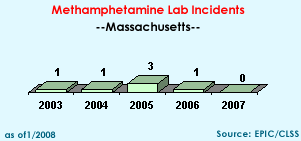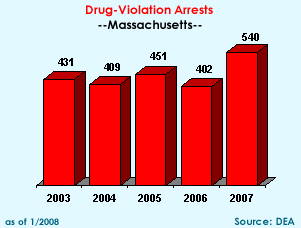|
DEA
Offices & Telephone Nos.
Boston—617-557-2100
Cape Cod—508-790-3713
Cross Border Initiative (CBI) 978-446-9191
Logan Airport 617-634-0305
New Bedford—508-996-4805
Springfield—413-785-0284
Worchester and Worchester Tactical Division—508-793-0110 |
State Facts
Population: 6,398,743
State Prison Population: 10,144
Probation Population: 163,471
Violent Crime Rate
National Ranking: 18 |
2007
Federal Drug Seizures
Cocaine: 118.8 kgs.
Heroin: 7.1 kgs.
Methamphetamine: 5.2 kgs./301
du
Marijuana: 279.2 kgs.
Hashish: 0.0 kgs.
MDMA: 0.0 kgs./48,340 du
Meth
Lab Incidents: 0
(DEA, state, and local) |
Drug
Situation: Cocaine and heroin continue to be the primary
drugs of abuse in the state of Massachusetts as Colombian and
Dominican traffickers dominate the distribution throughout the
state. OxyContin® remains extremely popular and has been seen
as a “gateway drug” to heroin use.
 Cocaine: Cocaine
is readily available from gram to kilogram quantities throughout the
state. New York had been the primary source area; however investigative
efforts confirm increased transportation of the drug directly from
the Mexican-United States border, as well as Florida and Georgia. Cocaine
is transported in multi-kilogram quantities via commercial transit,
tractor trailers, and vehicles equipped with hidden compartments. It
is also imported via mail services, commercial transit and livery services.
Importers are of Colombian and Dominican origin, along with the emergence
of Mexican drug trafficking organizations importing cocaine into the
region. The drugs retail distribution continues among all ethnic groups.
Cocaine prices and purity levels remain stable. Crack cocaine is converted
locally and/or obtained from New York, Florida and Puerto Rico. African
-American violators and street gang members continue to dominate the
drugs’ distribution. Abuse remains widespread and crack continues
to be reported as the drug of choice within Boston city limits. Cocaine: Cocaine
is readily available from gram to kilogram quantities throughout the
state. New York had been the primary source area; however investigative
efforts confirm increased transportation of the drug directly from
the Mexican-United States border, as well as Florida and Georgia. Cocaine
is transported in multi-kilogram quantities via commercial transit,
tractor trailers, and vehicles equipped with hidden compartments. It
is also imported via mail services, commercial transit and livery services.
Importers are of Colombian and Dominican origin, along with the emergence
of Mexican drug trafficking organizations importing cocaine into the
region. The drugs retail distribution continues among all ethnic groups.
Cocaine prices and purity levels remain stable. Crack cocaine is converted
locally and/or obtained from New York, Florida and Puerto Rico. African
-American violators and street gang members continue to dominate the
drugs’ distribution. Abuse remains widespread and crack continues
to be reported as the drug of choice within Boston city limits.
 Heroin: Heroin
is readily available from gram to kilogram quantities throughout the
state. Historically, New York had been the primary source area, with
the drug entering by interstate highway via publicly and privately
operated vehicles equipped with hidden compartments. However, there
continues to be increased transport of the drug directly from source
countries and/or the southwestern United States. The primary suppliers
are of Colombian and Dominican origin, with retail distribution among
all ethnic groups. Heroin distribution and use continues throughout
the state. While prices have remained low at both the wholesale and
retail level, heroin purity levels have begun to fluctuate with both
extremely high and low purity levels encountered at the street level.
Abuse continues to be widespread. Heroin: Heroin
is readily available from gram to kilogram quantities throughout the
state. Historically, New York had been the primary source area, with
the drug entering by interstate highway via publicly and privately
operated vehicles equipped with hidden compartments. However, there
continues to be increased transport of the drug directly from source
countries and/or the southwestern United States. The primary suppliers
are of Colombian and Dominican origin, with retail distribution among
all ethnic groups. Heroin distribution and use continues throughout
the state. While prices have remained low at both the wholesale and
retail level, heroin purity levels have begun to fluctuate with both
extremely high and low purity levels encountered at the street level.
Abuse continues to be widespread.
  Methamphetamine:
Methamphetamine is available in limited quantities and is transported
via express mail packages from California and the southwestern United
States. Recent seizures reflect the availability of crystal methamphetamine.
Methamphetamine is rarely abused throughout the state, but prevalent
among young adults between the ages of 18 to 25, members of the homosexual
community and occasionally abused by individuals in their late 30s to
early 40s. Methamphetamine:
Methamphetamine is available in limited quantities and is transported
via express mail packages from California and the southwestern United
States. Recent seizures reflect the availability of crystal methamphetamine.
Methamphetamine is rarely abused throughout the state, but prevalent
among young adults between the ages of 18 to 25, members of the homosexual
community and occasionally abused by individuals in their late 30s to
early 40s.
 Club
Drugs: In the state of Massachusetts, MDMA is
widely available and in significant quantities. MDMA is found
at rave parties, legitimate nightclubs, on college campuses
across the state as well as among members of the homosexual
community. Today, MDMA is primarily transported into New England
via the New York-Vermont border with increased involvement by
Asian drug trafficking organizations. There is limited abuse
of club drugs such as Ketamine and GHB. Club
Drugs: In the state of Massachusetts, MDMA is
widely available and in significant quantities. MDMA is found
at rave parties, legitimate nightclubs, on college campuses
across the state as well as among members of the homosexual
community. Today, MDMA is primarily transported into New England
via the New York-Vermont border with increased involvement by
Asian drug trafficking organizations. There is limited abuse
of club drugs such as Ketamine and GHB.
 Marijuana:
Marijuana remains readily available in all areas of the state with the
majority of commercial-grade product originating in Mexico or the
Southwest region of the United States; however, marijuana of both
Colombian and Jamaican origin has been encountered. Hydroponic marijuana,
which is cultivated predominately in Canada, also continues to be
available. Personal use quantities of hashish continue to arrive
in Boston on flights from the Netherlands and other source countries.
The majority of the marijuana is imported from the southwest border
via aircraft, land vehicles, and delivery services. Marijuana:
Marijuana remains readily available in all areas of the state with the
majority of commercial-grade product originating in Mexico or the
Southwest region of the United States; however, marijuana of both
Colombian and Jamaican origin has been encountered. Hydroponic marijuana,
which is cultivated predominately in Canada, also continues to be
available. Personal use quantities of hashish continue to arrive
in Boston on flights from the Netherlands and other source countries.
The majority of the marijuana is imported from the southwest border
via aircraft, land vehicles, and delivery services.
  Other
Drugs: Oxycodone
products continue to be diverted in the state. Percocet®, Roxicet® and
OxyContin® are readily available in Massachusetts. OxyContin® continues
to be the preferred pharmaceutical drug of abuse and is widely available.
The drug has been obtained from such areas as Arizona, Florida and
Nevada for distribution in the Massachusetts area. Traffickers continue
to divert OxyContin® via express mail shipments into the greater
Boston area. Along with well organized doctor shopping rings, forged
and/or altered prescriptions and diversion from individuals’ prescriptions
are the most commonly found diversion methods in the state. Other
Drugs: Oxycodone
products continue to be diverted in the state. Percocet®, Roxicet® and
OxyContin® are readily available in Massachusetts. OxyContin® continues
to be the preferred pharmaceutical drug of abuse and is widely available.
The drug has been obtained from such areas as Arizona, Florida and
Nevada for distribution in the Massachusetts area. Traffickers continue
to divert OxyContin® via express mail shipments into the greater
Boston area. Along with well organized doctor shopping rings, forged
and/or altered prescriptions and diversion from individuals’ prescriptions
are the most commonly found diversion methods in the state.
Pharmaceutical Diversion: Current
investigations indicate that diversion of oxycodone products such
as OxyContin® continues to be a problem in Massachusetts. Primary
methods of diversion are via illegal sale and distribution by health
care professionals and workers, “doctor shopping” (going
to a number of doctors to obtain prescriptions for a controlled pharmaceutical),
forged prescriptions, employee theft, pharmacy theft, and the Internet.
Methadone and Vicodin® were also identified as being among the
most commonly abused and diverted pharmaceuticals in Massachusetts.
DEA Mobile Enforcement Teams: This
cooperative program with state and local law enforcement counterparts
was conceived in 1995 in response to the overwhelming problem of drug-related
violent crime in towns and cities across the nation. Since the inception
of the MET Program, 473 deployments have been completed nationwide, resulting
in 19,643 arrests. There have been 18 MET deployments in the State of
Massachusetts since the inception of the program: Lynn, Revere, Webster,
Springfield, Lawrence, Everett, Fitchburg (2), Southbridge, Greenfield,
Holyoke, Framingham, Worcester (2), Boston (2), Provincetown, and Gloucester.
DEA
Regional Enforcement Teams:
This program was designed to augment existing DEA division resources
by targeting drug organizations operating in the United States where
there is a lack of sufficient local drug law enforcement. This program
was conceived in 1999 in response to the threat posed by drug trafficking
organizations that have established networks of cells to conduct drug
trafficking operations in smaller, non-traditional trafficking locations
in the United States. As of January 31, 2005, there have been 27 deployments
nationwide, and one deployment in the U.S. Virgin Islands, resulting
in 671 arrests. There have been no RET deployments in the state of Massachusetts.
Drug
Courts/Treatment Centers:
Based on information from the 2000 National Survey of Substance Abuse
Treatment Services, there are 356 substance abuse treatment centers in
Massachusetts. There are twenty drug courts across the state.
More information
about the New England Division Office.
Sources
Factsheet
last updated:
1/2008
Click
here for last year's factsheet >>
|

